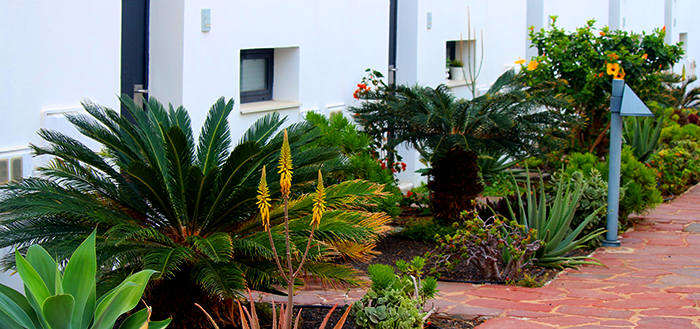
By Briana Smith | December 13, 2012
Water conservation during the winter? It’s actually the perfect time to research and map out the best way to tackle outside water conservation goals that can then be implemented in the spring.
There are many ways to be water wise in regards to landscaping either at home or the outside spaces at work. With excellent planning, proper installation & general maintenance your low water landscaping can look beautiful & be functional. Don’t forget to check with your local city/county office, as some offer rebates for water conservation-landscaping.
- Replace grass with artificial or synthetic turf/grass or other types of low water ground cover such as rocks/gravel/wood chips/etc.
- Look into permeable paving.
- Use drought-tolerant/low water plants &/or plants that are native to your region (find out what plant hardiness zone you live in)
- Plan out your landscape/garden for efficient watering; group plants into water zones that have similar needs.
- Consider xeriscaping, a landscaping method that reduces or conserves water, originally applied to arid or semi-arid regions, but can apply to any area.
- Have drainage problems? Consider regrading or other drainage solutions that will be easier to install once the weather is nicer.
- Irrigate efficiently & maintain sprinkler/irrigation system(s) by watching for leaks or sprinkler heads broken/pointed in the wrong direction.
- Choose the right sprinkler system for your needs.
- Consider drip irrigation & soaker hoses for watering, as opposed to traditional sprinkler systems, which tend to overwater; drip irrigation & soaker hoses allow water to flow exactly where you need the water most.
- Don’t water in the middle of the day, preferably water early in the morning so that the soil has a chance to absorb the water & it won’t evaporate as quickly.
- Don’t water when it’s raining; know how to shut off your automatic sprinkler system when it does rain. Better yet, get a rain sensor or soil moisture sensor that hooks up to your sprinkler system.
- Check to make sure that your plants need water. Many plants do not need daily watering, especially in winter.
- You can tell if a plant needs watering by checking whether or not the soil is dry 1-1/2 inches below the surface of the ground.
- Don’t know where to begin? Consult with an expert for ideas or landscape planning.
Did You Know...?

Briana Smith is WAXIE’s Social Media & Product Branding Specialist and spends quite a bit of time skimming the news for what’s new in cleaning, sustainability and technology while managing all of WAXIE’s social channels. She especially loves posting about #teamwaxie activities & conversing with customers on Instagram. Briana has a Bachelor's Degree in Communication Design from California State University, Chico.
Resources:
- Landscaping Advice for Energy-Efficient Homes: http://energy.gov/energysaver/articles/landscaping-energy-efficient-homes
- Garden & Landscaping Water Conservation Tips (for MA residents, but most of the tips are applicable everywhere): http://www.mwra.state.ma.us/comsupport/conservation/gardeningtips.htm
- Water Conservation Tips: Landscape Maintenance, Landscape Design, Irrigation & Indoor: http://www.ccwater.com/conserve/ConservationTips.asp
- USDA Plant Hardiness Zone Map: http://planthardiness.ars.usda.gov/PHZMWeb/
- Permeable Paving: http://en.wikipedia.org/wiki/Permeable_paving



